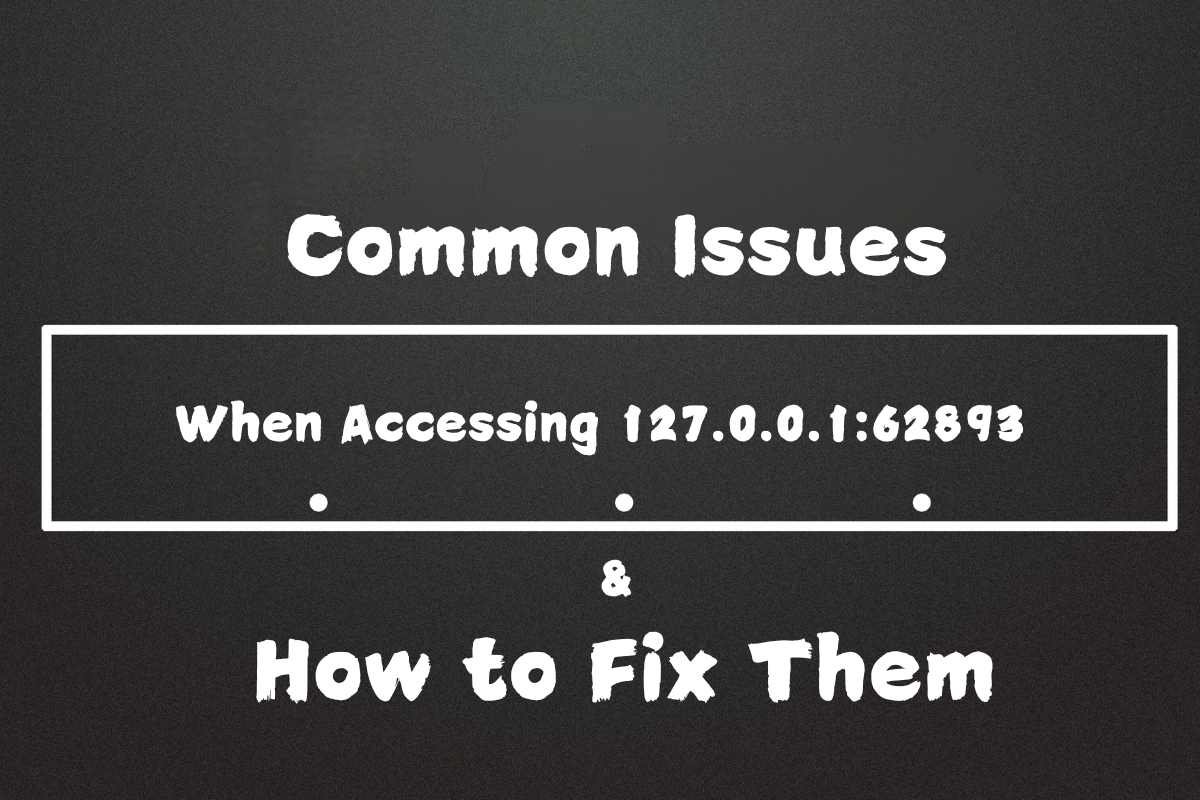Common Issues When Accessing 127.0.0.1:62893 and How to Fix Them
You’ve probably encountered the IP address 127.0.0.1 when working with local development environments. This address essentially refers to your local host your machine, and it’s crucial for local testing. Pair that with a port like 62893; you have a specific service running locally. But sometimes, things don’t go as planned, and you face problems accessing this address.
In this guide, we’ll break down the most common issues you might encounter when accessing 127.0.0.1:62893, why they happen, and, most importantly, how to fix them!
Understanding 127.0.0.1 and Port 62893
What is 127.0.0.1 (Localhost)?
Simply put, 127.0.0.1 is the IP address assigned to your local machine. When testing websites or services on your computer, you tell your device, “Hey, let’s talk to ourselves.” The term localhost is just a convenient alias for 127.0.0.1.
You’ll use localhost a lot in development to simulate how your application behaves in a production environment without it actually being public.
Role of Port 62893 in Localhost Connections
Now, let’s talk about port 62893. A port is essentially a doorway for services to communicate with the outside world, or in this case, with localhost. Different services use different ports. For example, HTTP traffic typically uses port 80, while port 8080 is popular for web servers. But port 62893? It’s likely something custom, maybe tied to a specific development tool or an app you’re testing.
Understanding how ports work is crucial because if something else is using port 62893, or if it’s misconfigured, you’re going to run into issues accessing your localhost service.
Common Issues Encountered When Accessing 127.0.0.1:62893
Even though localhost is supposed to make things easier, accessing 127.0.0.1:62893 can sometimes lead to errors. Let’s explore the most common problems:
1. Connection Refused Error
This is probably the most common issue. If you try accessing 127.0.0.1:62893 and see a “Connection Refused” error, it typically means that no service is actually running on that port.
Why does this happen?
- The service tied to port 62893 might not be started.
- There might be a firewall blocking access.
- The configuration could be incorrect, causing the service to bind to the wrong address.
2. Address Already in Use Error
Another common problem is the “Address Already in Use” error. This happens when another service or process is already occupying port 62893.
Why does this happen?
- Another application might have bound to the same port, leading to a conflict.
- The service didn’t shut down properly, leaving the port in use.
3. Timeouts or Slow Response Times
Trying to access 127.0.0.1:62893 but the request keeps timing out? Or maybe the page eventually loads, but painfully slowly.
Why does this happen?
- Local network issues or misconfigurations.
- The service on port 62893 may be underperforming or stuck in a loop, leading to slow responses.
- Hardware limitations, like lack of memory or CPU resources.
4. Service Not Running or Misconfigured
If you’re trying to access 127.0.0.1:62893, but nothing’s happening, the service you’re expecting might not even be running.
Why does this happen?
- The service wasn’t started, or it crashed without you noticing.
- Misconfiguration in your application or server settings may have caused it to fail.
5. Firewall or Security Software Blocking Access
Modern systems come with firewalls and antivirus software that might mistake localhost traffic for something malicious especially when custom ports like 62893 are involved.
Why does this happen?
- Firewall rules may be too restrictive, blocking requests to 127.0.0.1.
- Security software may interpret the local service as a threat and block access.
How to Diagnose Problems with 127.0.0.1:62893
Now that we’ve outlined the common problems, how can you figure out exactly what’s going wrong? Here are some useful tools and steps you can use to diagnose these issues.
1. Using Command Line Tools (ping, netstat, etc.)
Start by using tools like ping and netstat to check whether localhost is responding and which services are bound to port 62893.
Ping Example:

This will verify whether your system can communicate with localhost.
Netstat Example:

This checks whether anything is listening on port 62893.
2. Checking for Active Services on Port 62893

Use netstat or lsof to list active services running on port 62893. This can help you identify whether something’s already using the port or if it’s free.
3. Examining Service Logs for Errors
If the service running on 127.0.0.1:62893 has logs (which most do), check them! Look for anything that suggests a misconfiguration or error that’s causing the connection issue.
4. Testing 127.0.0.1:62893 with Different Browsers or Clients
Sometimes the issue isn’t with the service itself but with how you’re trying to access it. Try using different browsers or clients (like Postman for APIs) to rule out a client-side problem.
Step-by-Step Fixes for Common Issues
Now that you’ve diagnosed the problem, let’s dive into how you can fix these common issues.
1. Fixing Connection Refused Errors
To resolve the Connection Refused error, follow these steps:
- Ensure the service tied to port 62893 is running. If it’s not, start it.
- Double-check that the service is bound to 127.0.0.1:62893 and not another IP or port.
- Review your firewall settings and make sure they allow access to port 62893.
2. Addressing Port Conflicts (Address Already in Use)
If another service is using the port, you can:
- Find and stop the conflicting service using lsof or netstat.
- Reconfigure your service to use a different port if you can’t stop the other service.
- If it’s a zombie process (leftover from a crash), force-stop it with kill.
3. Improving Timeout and Response Times
If your localhost service is timing out:
- Check your machine’s CPU and memory usage. Sometimes, resource limits can cause services to slow down.
- Review the service configuration for performance issues, such as inefficient database queries or loops.
- Ensure your network configuration is optimized and not causing delays.
4. Configuring Firewall and Antivirus to Allow Localhost Connections
Adjust your firewall settings:
- Open your firewall or antivirus program and look for the localhost or loopback rules.
- Create an exception for port 62893 on 127.0.0.1 to allow traffic to pass through.
Preventive Measures to Avoid Future Issues
Once you’ve fixed the immediate issue, here’s how to prevent these problems from cropping up again in the future.
1. Properly Configuring Services on Localhost
Ensure that every service you run on localhost is configured properly:
- Define clear port assignments.
- Regularly update configurations and code to prevent unexpected failures.
2. Monitoring Ports and Services
Keep an eye on what’s running on your machine. Regularly check which services are using which ports to avoid conflicts.
3. Using Virtual Environments and Containers (Docker)
To avoid port conflicts and service failures, use containers like Docker. This lets you isolate services in their own environments, giving you full control over which ports are used.
Additional Resources and Tools for Troubleshooting
Here are some tools and resources that can help you further:
- Wireshark: For in-depth network traffic analysis.
- Fiddler: To inspect web requests.
- StackOverflow: Always a great place for troubleshooting localhost issues!
Conclusion
Accessing 127.0.0.1:62893 doesn’t always go smoothly, but with the right understanding of what localhost is and how ports work, you can quickly identify and resolve issues. Whether it’s a Connection Refused error, port conflict, or slow response times, troubleshooting is all about methodically diagnosing the problem.
We’ve covered common errors, step-by-step fixes, and preventive measures to help you avoid running into the same issues again. If you’re frequently working with localhost or custom ports like 62893, staying proactive by configuring services properly, monitoring your ports, and securing your firewall settings will save you time and headaches in the long run.
Still, encountering issues with localhost or specific ports? Let us know in the comments, and don’t hesitate to explore more advanced tools like Wireshark or Docker to fine-tune your development setup.
FAQs
1. Why am I getting a “Connection Refused” error on 127.0.0.1:62893?
This error usually means the service tied to port 62893 is not running or the application isn’t properly configured to listen on that port. Additionally, this could be caused by a firewall or security setting blocking your access. To resolve it, ensure the service is active and listening on the correct port, and verify firewall rules are not restricting local traffic.
2. How do I check if something is running on port 62893?
You can use command-line tools like netstat, lsof, or ss to check if a service is bound to port 62893. These tools display a list of all active connections and the ports they’re using. For example, running lsof -i :62893 will show if any service is actively using that port, helping you determine if the port is available or already in use.
3. Can firewall settings block 127.0.0.1 connections?
Yes, firewalls or security software can block traffic to 127.0.0.1, especially if custom ports like 62893 are involved. Firewalls may interpret traffic on non-standard ports as suspicious or unwanted. To allow localhost connections, configure your firewall or antivirus settings to permit traffic through 127.0.0.1 on the specific port you’re using, like 62893.
4. How do I fix the “Address Already in Use” error on 127.0.0.1:62893?
This error means another service is already using port 62893. You can resolve it by identifying the conflicting process with tools like lsof or netstat, terminating that service, or reassigning your application to a different, unused port. In some cases, a service may have crashed and left the port occupied, in which case restarting your machine or killing the process should free up the port.
5. Is it safe to run services on localhost using port 62893?
Yes, running services on localhost (127.0.0.1) is generally safe since localhost traffic is only accessible from your machine and isn’t exposed to the wider internet. However, if you’re developing sensitive applications, securing your local host services with proper authentication and firewall rules is crucial to ensure they remain protected even during local development.
6. Can I change the port from 62893 to something else?
Yes, most services allow you to configure which port they listen on. If port 62893 is causing conflicts or needs to be freed, you can change it by modifying the application’s configuration file or command-line options. Just make sure the new port isn’t already in use and is appropriately allowed through your firewall to avoid any additional issues.














Post Comment